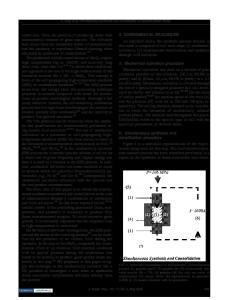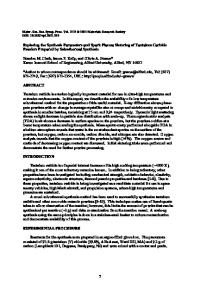Simultaneous spark plasma synthesis and consolidation of WC/Co composites
- PDF / 5,153,194 Bytes
- 8 Pages / 612 x 792 pts (letter) Page_size
- 60 Downloads / 273 Views
Roberto Orrùa) and Giacomo Caob) Dipartimento di Ingegneria Chimica e Materiali, Centro Studi sulle Reazioni Autopropaganti (CESRA), and Unità di Ricerca del Consorzio Interuniversitario per la Scienza e Tecnologia dei Materiali (INSTM), Università degli Studi di Cagliari, 09123 Cagliari, Italy; and PROMEA Scarl, c/o Dipartimento di Fisica, Cittadella Universitaria di Monserrato, 09042 Monserrato (CA), Italy (Received 29 July, 2004; accepted 15 December, 2004)
The single-step synthesis and densification of the WC–6Co cemented carbide starting from elemental powders was obtained by the spark plasma sintering (SPS) technique. The operating conditions that guarantee the complete conversion of the reactants to the desired full dense material have been identified. Specifically, under the application of 800 A and a mechanical pressure of 40 MPa for about 200 s, a product with relative density higher than 99%, hardness of 14.97 ± 0.35 GPa, and 12.5 ± 1.0 MPa m0.5 fracture toughness was obtained. A kinetic investigation of the SPS process was also performed. It revealed that an intermediate phase, i.e., W2C, is the first carbide formed during the carburization process. It was observed that the synthesis and sintering stages take place simultaneously. It was also found that as the applied pulsed current intensity was augmented, the synthesis/sintering time required decreased significantly.
I. INTRODUCTION
It is well known that WC–Co cermet materials possess attractive mechanical properties, i.e., wear/abrasion resistance, high hardness, and elastic modulus, as well as a good fracture toughness, which make them extensively used in several areas, in particular, as cutting and machining tools.1–3 Therefore, due to their practical importance, several studies have been conducted in the last decades to investigate and improve their mechanical properties. Typically, dense cemented tungsten carbides are produced following two steps. First, powders of WC are synthesized, and subsequently, the obtained powders are subjected to a sintering/consolidation process after they are mixed with the metal binder. Several methods of synthesizing WC powders have been proposed. Carburization of tungsten powder at high temperature is typically used to produce tungsten carbide.4,5 With the goal of obtaining nanostructured
Address all correspondence to these authors. a) e-mail: [email protected] b) e-mail: [email protected] DOI: 10.1557/JMR.2005.0096 734
http://journals.cambridge.org
J. Mater. Res., Vol. 20, No. 3, Mar 2005 Downloaded: 17 Mar 2015
powders, other techniques including, for example, ball milling,6–8 spray conversion process (SCP),9 and spray thermal decomposition,5 have also been used recently. Moreover, 99% pure WC powders with 1–2 m particle size were prepared from elements through the Selfpropagating high-temperature synthesis (SHS) method in the presence of a highly exothermic mixture (Mg + Teflon) as reaction promoter.10 Regarding the consolidation stage, besides conventional sintering methods, hot pressing (HP)
Data Loading...











